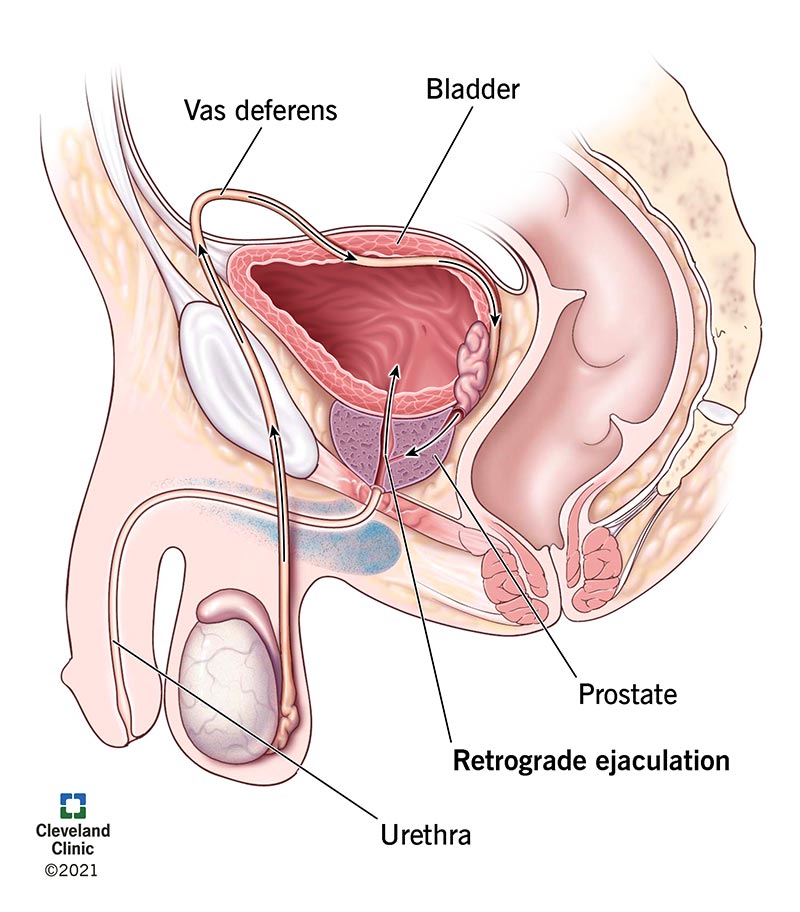Retrograde ejaculation is also called dry orgasm. It happens when sperm doesn’t leave the body through the penis but is pushed back into the bladder where urine is stored. It may be found during examinations for fertility.
Advertisement
Cleveland Clinic is a non-profit academic medical center. Advertising on our site helps support our mission. We do not endorse non-Cleveland Clinic products or services. Policy

Retrograde ejaculation is a term that refers to semen going backward into your bladder instead of out of your body through your urethra and the tip of your penis during sexual climax. The urethra is the tube that lets urine and sperm leave your body.
Advertisement
Cleveland Clinic is a non-profit academic medical center. Advertising on our site helps support our mission. We do not endorse non-Cleveland Clinic products or services. Policy
Retrograde ejaculation is also called dry orgasm. It can be a factor in infertility.
Retrograde ejaculation often affects individuals who:
Retrograde ejaculation is somewhat common. For instance, it happens after most cases of transurethral resection of the prostate (TURP) surgeries. TURP is used to treat benign prostatic hyperplasia, also called an enlarged prostate.
Conditions that may cause retrograde ejaculation are also somewhat common, such as diabetes. In terms of medications, individuals who take drugs for high blood pressure or depression may develop retrograde ejaculation.
You might not notice if you have retrograde ejaculation. Or you might notice the following:
Retrograde ejaculation is caused by a problem with your circular muscle (called the bladder sphincter) that closes to let semen out and keeps urine in your body. Because your sphincter doesn’t work correctly, your bladder neck stays open instead of closing allowing the ejaculate to take the path of least resistance into the bladder.
Advertisement
Your provider will ask you questions about your symptoms and will do a physical examination. Then, to diagnose retrograde ejaculation, your healthcare provider may ask you to provide:
Retrograde ejaculation doesn’t seem to be painful or harmful. If you don’t want children, your provider may suggest that it doesn’t need treatment.
However, if you decide you want treatment, there are medications that help the sphincter close tightly. These include imipramine, an older antidepressant, and antihistamines like pseudoephedrine and chlorpheniramine.
If your condition is actually being caused by the medications you’re on, talk with your provider about making a change to a different type of drug.
If you have retrograde ejaculation and you take imipramine or pseudoephedrine, your healthcare provider will keep an eye on your blood pressure and heart rate. The drugs make increase both blood pressure and heart rate.
If the drugs don’t work to help with retrograde ejaculation, there are still ways to aid fertility. For instance, your provider can collect your sperm so that it can be used for insemination.
You may want to work on the muscles that control urination. You can tell which ones these are by stopping and starting your flow while you’re peeing. Exercising them involves squeezing and releasing these muscles. These exercises are often called Kegel exercises.
There’s no way to prevent retrograde ejaculation. But if you have diabetes, it’s important to keep your blood sugar levels steady. It’s vital for your overall health as well as your penis health.
Healthcare professionals don’t believe that retrograde ejaculation is harmful or painful. Your outlook is good, unless you’re trying to have children. Even then, there are treatments for both retrograde ejaculation and infertility.
You should contact your healthcare provider if:
Retrograde ejaculation feels the same as antegrade ejaculation. Antegrade ejaculation is the term for semen forcefully being pushed out of the body through the penis, rather than being forcefully pushed back into the bladder. However, if you’re uncomfortable for any reason with the lack of semen during orgasm, contact your healthcare provider.
Advertisement
Retrograde ejaculation can go away with treatment. It can also go away if you’re able to change the medications that cause it.
The rate of retrograde ejaculation after TURP is estimated to be as high as 70% to 90%. If the bladder neck is preserved during TURP, there may be less risk of retrograde ejaculation.
Some people believe that retaining sperm will increase their testosterone levels or will allow them to live longer. These people make an effort to stop themselves from ejaculating outside the body. However, this is controversial and not recommended by most healthcare providers.
Retrograde ejaculation is a somewhat common occurrence due to many causes, including medication use, surgery and medical conditions. While healthcare providers don’t see it as being painful or harmful, it can be a problem for people who want to conceive. There are ways to treat retrograde ejaculation. Speak to your healthcare provider about any of your concerns.
Advertisement
Infertility can change your plans. Cleveland Clinic’s experts can work with you to get to the bottom of male infertility and create a customized treatment plan.

Last reviewed on 09/28/2021.
Learn more about the Health Library and our editorial process.